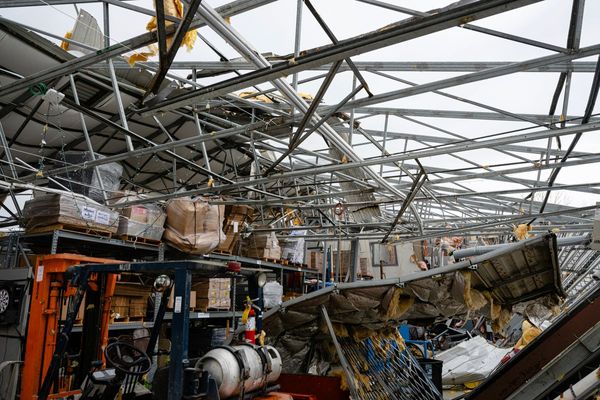
Claude Monet’s monumental triptych Water Lilies 1914 -26, which depicts nature’s tranquil beauty as part of the French impressionist’s world-famous series, will take on new meaning in a giant recreation by artist and activist Ai Weiwei in his new London exhibition.
Monet’s brushstrokes in his water and reflection landscapes are replaced by about 650,000 studs of Lego bricks, in 22 vivid colours, in the 15-metre-long work at the centre of Weiwei’s biggest UK show in eight years, opening next month.
Entitled Water Lilies #1, it is the largest Lego artwork by the celebrated global artist since he first adopted the medium in 2014 to produce portraits of political prisoners, and will span the entire length of one of the walls of the Design Museum gallery in Kensington, west London, where his first design-focused exhibition opens on Friday 7 April.
In the original masterpiece, Monet depicts one of the lily ponds in the gardens of his home in Giverny, near Paris, one of a series of paintings of the lily ponds with which the artist was infatuated. Yet, though his works are seen as a celebration of the natural world, the pond and gardens were human-made, designed and created by Monet at the turn of the 20th century. He even had the nearby river Epte partially diverted to perfect his idealised landscape.
In recreating the famous scene, Ai Weiwei aims to challenge ideas of reality and beauty. The oil brushstrokes are replaced with the “depersonalised language of industrial parts and colours”, said the museum’s chief curator, Justin McGuirk, while the “pixel-like blocks suggest contemporary digital technologies which are central to modern life, and in reference to how art is often disseminated in the contemporary world”.
Ai has intensified the colours compared with the original. He has also personalised his version, which arrived at the museum in 10 preassembled panels.
Included on the right-hand side and “brutally puncturing the watery paradise”, said McGuirk, is a dark portal. This is the door to the underground dugout in Xinjiang where he and his poet father, Ai Qing, lived in forced exile in the 1960s.
Ai said: “Our world is complex and collapsing towards an unpredictable future. It’s crucial for individuals to find a personalised language to express their experience of these challenging conditions. Personalised expression arises from identifying with history and memories while creating a new language and narrative.
“Without a personal narrative, artistic narration loses its quality. In Water Lilies #1, I integrate Monet’s impressionist painting, reminiscent of Zenism in the east, and concrete experiences of my father and me into a digitised and pixelated language.

“Toy bricks as the material, with their qualities of solidity and potential for deconstruction, reflect the attributes of language in our rapidly developing era where human consciousness is constantly dividing.”
Water Lilies #1 will be seen alongside another major new Lego artwork by Ai, Untitled (Lego Incident), part of a series of five expansive “fields” where hundreds of thousands of objects will be laid out on the gallery floor. This field comprises thousands of Lego blocks donated by members of the public after Lego briefly refused to sell their products to him in 2014. Another will comprise 200,000 porcelain teapot spouts from the Song dynasty dating from 960-1279CE, while another features 1,600 neolithic stone tools.
McGuirk said:“Several of the works in this exhibition capture the destruction of urban development in China over the last two decades. With Water Lilies #1 Ai Weiwei presents us with an alternate vision – a garden paradise.
“On the one hand he has personalised it by inserting the door of his desert childhood home, but on the other he has used an industrial language of modular Lego blocks. This is a monumental, complex and powerful work and we are proud to be the first museum to show it.”
Other exhibition highlights include dozens of objects and artworks from throughout his career exploring the tensions between past and present, hand and machine, precious and worthless, construction and destruction, such as his Han dynasty urn emblazoned with a Coca-Cola logo, which epitomises these clashes.
A number of examples of Ai’s “ordinary” objects, where he has transformed something useful into something useless but valuable, will also be shown. These include a worker’s hard hat cast in glass which becomes at once strong and fragile, and a sculpture of an iPhone that has been cut out of a jade axe head.
Large-scale Ai Weiwei works will also be installed outside the exhibition gallery, in the museum’s free-to-enter spaces as well as outside the building.
Ai Weiwei: Making Sense runs at the Design Museum from 7 April to 30 July 2023. Tickets are available to pre-book now.







